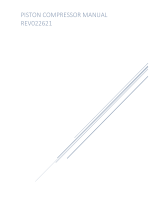
CA / CT SERIES CAP600
Page 12 of 30 REV E JULY 2014
Step 5 – Tighten the fasteners
Incrementally tighten the mounting bolts evenly in a cross pattern. With unit running, continue
incrementally tightening the mounting bolts in a crossing pattern until vibrations have been
reduced to an acceptable level. After vibrations have been minimized, loosen ONE mounting
bolt. The unit expands and contracts with changes in temperature, leaving ONE bolt loosened
will allow for thermal expansion of the unit, reducing thermal stresses and vibrations on the
tank. If after loosening one bolt the vibrations get worse, retighten bolt and select a different
fastener. Excessive vibrations can damage equipment.
Step 6 – Install piping network
Run a clean pipe to the tank discharge opening, bushing up or down as necessary with clean
bushings and fittings. Note that the more bushings and fittings placed in the air distribution
system, the greater the opportunity for air leaks and breaks. FS Curtis recommends the
installation of drip legs in the distribution piping.
Always install a safety relief valve in the distribution line between the compressor unit and in-
line shutoff valves. If more than one compressor pumps into a common system, a check valve
in the distribution line of each compressor unit is recommended to prevent moisture from
entering the cylinder head(s) when one compressor is idle. A globe or gate valve (WOG rated)
installed in the discharge line will allow compressor isolation from plant air system for
compressor maintenance. (Note: A safety relief valve should be located between the
compressor and the globe/gate valve.)
Step 7 – Install Compressor Intake (IF APPLICABLE)
If the compressor intake is to be located away from the unit, please use the following
instructions to ensure safe and efficient operation.
Run a clean pipe to the compressor suction opening, bushing up or down as necessary with
clean bushings and fittings. Note that the more bushings and fittings placed in the intake line,
the greater opportunity for air leaks and breaks. If the run is over 10 feet in length, use a larger
pipe diameter to avoid excessive pressure drops. When installing the pipes, please pitch the
piping down and slightly away from the intake, to ensure that debris and condensation drains
away from the compressor.
MOUNTING MOBILE UNITS
Gas engine driven compressors mounted to truck beds should be fastened to the truck bed in
such a way so as not to create any stress to the air receiver tank, isolator pads are required for
warranty purposes. Truck beds, characteristically, have a tendency to flex and could cause
damage to the receiver tank if the tank is fastened directly to the truck bed. It is the User’s
responsibility to provide an adequate means of fastening the unit in these applications.


























